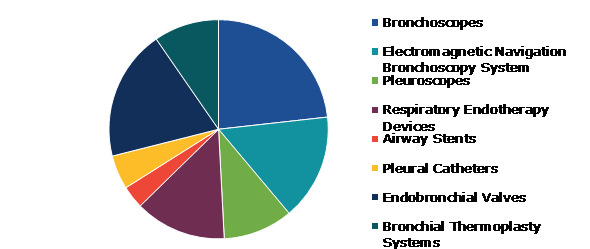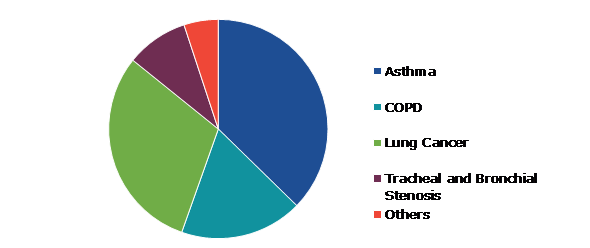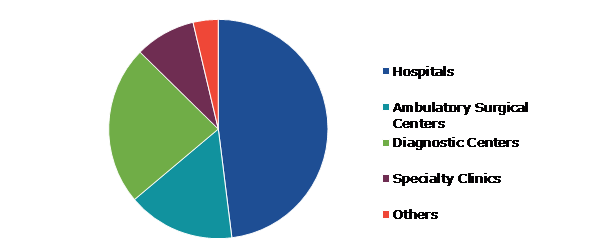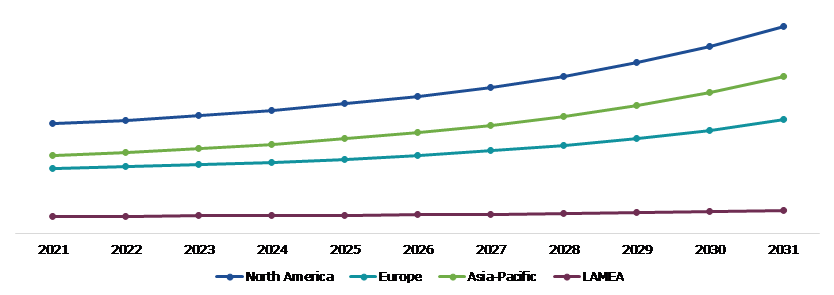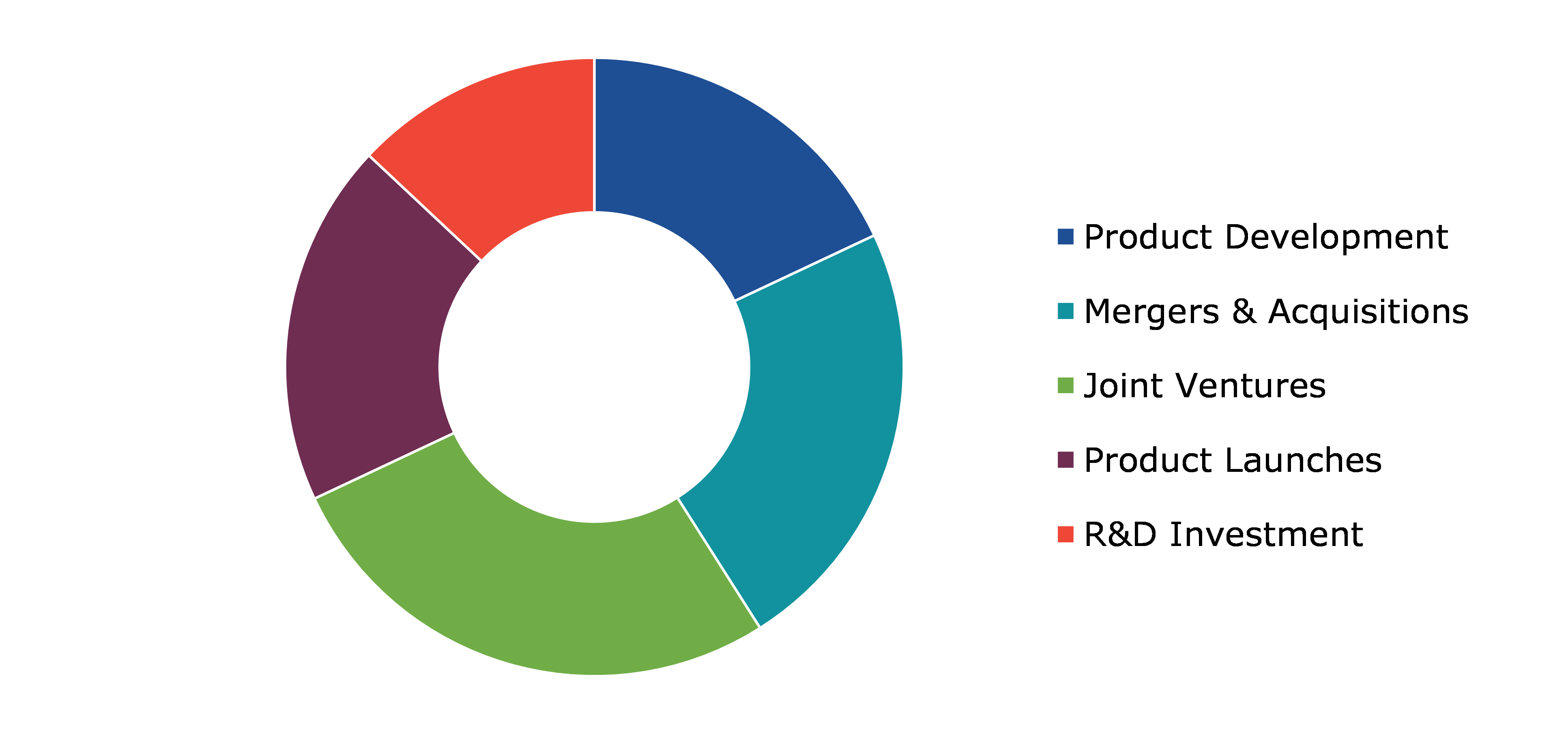Interventional Pulmonology Market Report
RA08654
Interventional Pulmonology Market by Product (Bronchoscopes, Electromagnetic Navigation Bronchoscopy System, Pleuroscopes, Respiratory Endotherapy Devices, Airway Stents, Pleural Catheters, Endobronchial Valves, and Bronchial Thermoplasty Systems), Indication (Asthma, COPD, Lung Cancer, Tracheal and Bronchial Stenosis, and Others), End User (Hospitals, Ambulatory Surgical Centers, Diagnostic Centers, Specialty Clinics, and Others), and Regional Analysis (North America, Europe, Asia-Pacific, and LAMEA): Global Opportunity Analysis and Industry Forecast, 2022-2031
Global Interventional Pulmonology Market Analysis
The Global Interventional Pulmonology Market Size was $3,714.30 million in 2021 and is predicted to grow with a CAGR of 6.7%, by generating a revenue of $6,903.70 million by 2031.
Global Interventional Pulmonology Market Synopsis
The prevalence of respiratory diseases such as asthma, bronchitis, and COPD has increased globally, leading to a higher demand for pulmonology treatments. In addition, the aging population is also contributing to the rise in respiratory diseases, as elderly individuals are more prone to develop lung problems. Increase in the prevalence of these diseases has led to a growing demand for pulmonology treatments, driving the growth of the interventional pulmonology market. Moreover, advancements in technology have led to the development of new diagnostic tools and treatments for respiratory diseases, further increasing the demand for pulmonology services. The growing awareness among people about respiratory diseases and their treatments has also driven the market growth. These factors are anticipated to boost the interventional pulmonology market growth in the upcoming years.
However, some of the disadvantages of interventional pulmonology include a lack of awareness about pulmonology and respiratory diseases. In addition, the lack of awareness about the importance of preventative measures such as vaccination and regular check-ups further exacerbates lung problems. Moreover, the cultural stigma surrounding respiratory diseases and the associated costs of treatment often restrict people from seeking medical attention, leading to a delay in diagnosis and treatment. The lack of awareness also affects the development of policies and programs aimed at reducing the burden of respiratory diseases. All these are the major factors projected to hamper the growth of the market during the forecast period.
The interventional pulmonology market size is expected to grow significantly in the upcoming years due to increase in the prevalence of respiratory diseases such as chronic obstructive pulmonary disease (COPD), asthma, and lung cancer. The increase in demand for early diagnosis and treatment of respiratory disorders, and the development of new technologies and devices for pulmonary function testing, are some of the key factors driving the growth of the market. Moreover, the rise in tobacco consumption, air pollution, and an aging population also contribute to the interventional pulmonology market expansion. In addition, the growing healthcare expenditure and increasing government funding for R&D in the field of pulmonology are also expected to boost the market growth in the future.
According to regional analysis, the North America interventional pulmonology market accounted for the highest market share in 2021. Recent FDA approvals, a large number of drugs in development, an increase in attention to lowering the number of undiagnosed asthma cases, and accessibility to early therapy in the region can all be attributed to this. According to Clinical Decision Support (CDS), asthma is considered to have contributed to 183,000 hospital stays and 1.6 million visits to emergency departments in the U.S. in 2017.
Interventional Pulmonology Overview
Interventional pulmonology has transformed the field of pulmonary (lung and breathing) medicine by offering the most advanced minimally invasive procedures for diagnosing and treating both malignant and non-malignant disorders of the lungs and airways. Lung cancer, thoracic cancer, and other illnesses of the respiratory system are diagnosed and treated using minimally invasive, non-surgical techniques by interventional pulmonology.
COVID-19 Impact on Global Interventional Pulmonology Market
The COVID-19 pandemic has had a significant impact on the interventional pulmonology market. With the outbreak of the pandemic, the demand for respiratory devices and equipment, such as ventilators, oxygen concentrators, and face masks, has increased. This has led to an increase in the production and sales of these products and a corresponding increase in the overall value of the pulmonology market. However, the pandemic has also caused disruptions to the supply chains of many pulmonology-related products, leading to shortages of interventional pulmonology products and increased prices. In addition, many hospitals and healthcare facilities postponed or canceled non-emergency procedures, such as pulmonary function tests and sleep studies, leading to a decrease in revenue for pulmonologists and related businesses during the pandemic. The COVID-19 impact on interventional pulmonology market also created new opportunities for telemedicine and remote patient monitoring in pulmonology, as social distancing measures made in-person visits more difficult. This has led to an increase in demand for digital health tools and remote monitoring devices, which has further impacted the pulmonology market. Furthermore, the COVID-19 pandemic has had both positive and negative effects on the interventional pulmonology market, with the impact varying depending on the specific product or service.
Increasing Prevalence of Chronic Obstructive Pulmonary Diseases and Asthma is Expected to Drive the Market Growth
There has been a significant increase in the number of people suffering from respiratory diseases such as asthma, COPD, and lung cancer, leading to an increase in demand for pulmonology treatments and services. According to the World Health Organization (WHO), chronic respiratory diseases are estimated to affect more than 339 million people worldwide and are responsible for approximately 4.3 million deaths annually. The rise in air pollution, smoking, and unhealthy lifestyles are contributing to the rise in respiratory diseases, driving the growth of the pulmonology market. Furthermore, advancements in pulmonology treatments and advanced medical devices, such as bronchoscopes, spirometers, and oxygen concentrators, have helped in improving the diagnostic and treatment processes. These factors are projected to drive the interventional pulmonology industry growth during the forecast period.
To know more about global interventional pulmonology market drivers, get in touch with our analysts here.
Limited Access to Healthcare Services to Restrain the Market Growth
In many developing countries, access to healthcare services, especially specialized medical care, is limited due to various factors such as poverty, lack of infrastructure, and a shortage of trained healthcare professionals. This can restrict the growth of the interventional pulmonology market, as patients in these countries may not have access to essential services such as diagnostic tests, treatments, and pulmonary rehabilitation programs. In addition, the cost of healthcare services may be too high for many individuals, further limiting access, which is anticipated to hamper the interventional pulmonology market growth in the future.
Growing Demand for Pulmonology Treatments to Create Excellent Opportunities in the Market
Interventional pulmonology is widely used for the development of treatments. The increase in awareness about respiratory diseases and the availability of improved diagnostic techniques is driving the demand for pulmonology treatments. This is leading to an increase in focus on early detection and treatment of these diseases, thereby providing a major opportunity for growth in the interventional pulmonology market. The development of advanced pulmonology devices, such as spirometers, peak flow meters, and pulse oximeters, has made it easier to diagnose and monitor respiratory diseases. This has resulted in an increase in demand for these devices, providing a major opportunity for the interventional pulmonology market growth. Governments of various countries around the world are investing in healthcare infrastructure and increasing their support for healthcare services. This is providing a major boost to the interventional pulmonology market, as it helps to improve the availability of pulmonology treatments.
To know more about global interventional pulmonology market opportunities, get in touch with our analysts here.
Global Interventional Pulmonology Market, by Product
Based on product, the market has been divided into bronchoscopes, electromagnetic, avigation bronchoscopy system, pleuroscopes, respiratory endotherapy devices, airway stents, pleural catheters, endobronchial valves, and bronchial thermoplasty systems. Among these, the bronchoscopes sub-segment accounted for the highest market share in 2021 and is estimated to show the fastest growth during the forecast period.
Global Interventional Pulmonology Market Share, by Product, 2021
Source: Research Dive Analysis
The bronchoscopes sub-segment accounted for the highest interventional pulmonology market share in 2021 and is anticipated to show the fastest growth during the forecast period. The most common interventional pulmonology procedure performed through the bronchoscope is bronchoscopy. Bronchoscopy can be done with either reusable or single-use bronchoscopes. Both single-use and reusable bronchoscopes are designed for use during the endoscopic examination, diagnosis, and treatment of the airways and tracheobronchial tree. COPD, tumors, lung cancer, airway stenosis, pneumonia, bronchitis, and other lung infections can all be diagnosed using a single-use bronchoscope. Factors such as an increase in the number of cases of respiratory diseases, product developments that improve reimbursement policies, and technological advancements are expected to drive the market growth further.
Global Interventional Pulmonology Market, by Indication
Based on indication, the market has been divided into asthma, COPD, lung cancer, tracheal and bronchial stenosis, and others. Among these, the asthma sub-segment accounted for the highest revenue share in 2021.
Global Interventional Pulmonology Market Size, by Indication, 2021
Source: Research Dive Analysis
The asthma sub-segment accounted for the highest interventional pulmonology market share in 2021. Asthma affects people of all ages, though it usually affects kids. It is a disease marked by recurrent bouts of shortness of breath and wheezing that vary in severity and frequency from person to person. It can happen from hour to hour and day to day in an individual. The market for asthma is expanding owing to the rising asthma prevalence and an aging population. The leading players in the global market for asthma medications may benefit from lucrative growth potential brought on by ongoing R&D efforts and technical improvements.
Global Interventional Pulmonology Market, by End User
Based on end user, the market has been divided into hospitals, ambulatory surgical centers, diagnostic centers, specialty clinics, and others. Among these, the hospitals sub-segment accounted for the highest revenue share in 2021.
Global Interventional Pulmonology Market Growth, by End User, 2021
Source: Research Dive Analysis
The hospitals sub-segment accounted for the highest market share in 2021. The high patient preference for hospital-based treatment and procedures, availability of skilled healthcare professionals, technologically advanced facilities, and favorable reimbursement scenario all contribute to the end user segment market share. In addition, adoption and use of advanced medical devices in healthcare facilities such as hospitals would be aided by improved healthcare infrastructure and increased healthcare spending by relevant government agencies. Therefore, the interventional pulmonology market demand is expected to increase in the upcoming years.
Global Interventional Pulmonology Market, Regional Insights
The interventional pulmonology market analysis was investigated across North America, Europe, Asia-Pacific, and LAMEA.
Global Interventional Pulmonology Market Size & Forecast, by Region, 2021-2031 (USD Million)
Source: Research Dive Analysis
The Market for Interventional Pulmonology in North America to be the Most Dominant
The North America interventional pulmonology market accounted for the highest market share in 2021. North America's large share of the global interventional pulmonology market can be attributed to an increase in the incidence and prevalence of chronic respiratory diseases, a favorable reimbursement scenario in the U.S., and an increase in the incidence of lung cancer in Canada. The Asthma and Allergy Foundation of America estimates that there are around 25 million asthma patients in the U.S. or almost 1 in every 13 people. Asthma affects nearly 20 million Americans who are over 18 years old. Adult females are more likely to have asthma than adult males. More than 6.1% of adult males and 9.8% of adult females suffer from asthma. These factors are anticipated to drive the regional market growth during the forecast period.
Competitive Scenario in the Global Interventional Pulmonology Market
Investment and agreement are common strategies followed by major market players. For instance, in August 2020, The Olympus corporation recalled BF-Q180 bronchoscopes after failing a 510(k) clearance and being linked to a higher rate of patient infection than other Olympus medical system corporation bronchoscopes.
Source: Research Dive Analysis
Some of the leading interventional pulmonology market players are Huger Medical Instrument Co. Ltd, Medtronic Plc, Boston Scientific Corporation, Olympus Corporation, FUJIFILM Corporation, Becton, Smith’s Group Plc, Cook Medical, Vygon, and Clarus Medical LLC
| Aspect | Particulars |
| Historical Market Estimations | 2020 |
| Base Year for Market Estimation | 2021 |
| Forecast Timeline for Market Projection | 2022-2031 |
| Geographical Scope | North America, Europe, Asia-Pacific, and LAMEA |
| Segmentation by Product |
|
| Segmentation by Indication |
|
| Segmentation by End User |
|
| Key Companies Profiled |
|
Q1. What is the size of the global interventional pulmonology market?
A. The size of the global interventional pulmonology market was over $3,714.30 million in 2021 and is projected to reach $6,903.70 million by 2031.
Q2. Which are the major companies in the interventional pulmonology market?
A. Boston Scientific Corporation, Olympus Corporation, and FUJIFILM Corporation are some of the key players in the global interventional pulmonology market.
Q3. Which region, among others, possesses greater investment opportunities in the future?
A. Asia-Pacific possesses great investment opportunities for investors in the future.
Q4. What will be the growth rate of the Asia-Pacific interventional pulmonology market?
A. Asia-Pacific interventional pulmonology market is anticipated to grow at 7.6% CAGR during the forecast period.
Q5. What are the strategies opted by the leading players in this market?
A. Agreement and investment are the two key strategies opted by the operating companies in this market.
Q6. Which companies are investing more on R&D practices?
A. Boston Scientific Corporation, Olympus Corporation, FUJIFILM Corporation, and Becton are the companies investing more on R&D activities for developing new products and technologies.
1.Research Methodology
1.1.Desk Research
1.2.Real time insights and validation
1.3.Forecast model
1.4.Assumptions and forecast parameters
1.5.Market size estimation
1.5.1.Top-down approach
1.5.2.Bottom-up approach
2.Report Scope
2.1.Market definition
2.2.Key objectives of the study
2.3.Report overview
2.4.Market segmentation
3.Overview of the impact of COVID-19 on the global Interventional Pulmonology market
4.Executive Summary
5.Market Overview
5.1.Introduction
5.2.Growth impact forces
5.2.1.Drivers
5.2.2.Restraints
5.2.3.Opportunities
5.3.Market value chain analysis
5.3.1.List of raw material suppliers
5.3.2.List of manufacturers
5.3.3.List of distributors
5.4.Innovation & sustainability matrices
5.4.1.Technology matrix
5.4.2.Regulatory matrix
5.5.Porter’s five forces analysis
5.5.1.Bargaining power of suppliers
5.5.2.Bargaining power of consumers
5.5.3.Threat of substitutes
5.5.4.Threat of new entrants
5.5.5.Competitive rivalry intensity
5.6.PESTLE analysis
5.6.1.Political
5.6.2.Economical
5.6.3.Social
5.6.4.Technological
5.6.5.Environmental
5.7.Impact of COVID-19 on the Interventional Pulmonology market
5.7.1.Pre-covid market scenario
5.7.2.Post-covid market scenario
5.8.Interventional Pulmonology Market Analysis, by Product Overview
5.9.Bronchoscopes
5.9.1.Definition, key trends, growth factors, and opportunities
5.9.2.Market size analysis, by region, 2021-2031
5.9.3.Market share analysis, by country, 2021-2031
5.10.Electromagnetic Navigation Bronchoscopy System
5.10.1.Definition, key trends, growth factors, and opportunities
5.10.2.Market size analysis, by region, 2021-2031
5.10.3.Market share analysis, by country, 2021-2031
5.11.Pleuroscopes
5.11.1.Definition, key trends, growth factors, and opportunities
5.11.2.Market size analysis, by region, 2021-2031
5.11.3.Market share analysis, by country, 2021-2031
5.12.Respiratory Endotherapy Devices
5.12.1.Definition, key trends, growth factors, and opportunities
5.12.2.Market size analysis, by region, 2021-2031
5.12.3.Market share analysis, by country, 2021-2031
5.13.Airway Stents
5.13.1.Definition, key trends, growth factors, and opportunities
5.13.2.Market size analysis, by region, 2021-2031
5.13.3.Market share analysis, by country, 2021-2031
5.14.Pleural Catheters
5.14.1.Definition, key trends, growth factors, and opportunities
5.14.2.Market size analysis, by region, 2021-2031
5.14.3.Market share analysis, by country, 2021-2031
5.15.Endobronchial Valves
5.15.1.Definition, key trends, growth factors, and opportunities
5.15.2.Market size analysis, by region, 2021-2031
5.15.3.Market share analysis, by country, 2021-2031
5.16.Bronchial Thermoplasty Systems
5.16.1.Definition, key trends, growth factors, and opportunities
5.16.2.Market size analysis, by region, 2021-2031
5.16.3.Market share analysis, by country, 2021-2031
5.17.Research Dive Exclusive Insights
5.17.1.Market attractiveness
5.17.2.Competition heatmap
6.Interventional Pulmonology Market Analysis, by Indication
6.1.Asthma
6.1.1.Definition, key trends, growth factors, and opportunities
6.1.2.Market size analysis, by region, 2021-2031
6.1.3.Market share analysis, by country, 2021-2031
6.2.COPD
6.2.1.Definition, key trends, growth factors, and opportunities
6.2.2.Market size analysis, by region, 2021-2031
6.2.3.Market share analysis, by country, 2021-2031
6.3.Lung Cancer
6.3.1.Definition, key trends, growth factors, and opportunities
6.3.2.Market size analysis, by region, 2021-2031
6.3.3.Market share analysis, by country, 2021-2031
6.4.Tracheal and Bronchial Stenosis
6.4.1.Definition, key trends, growth factors, and opportunities
6.4.2.Market size analysis, by region, 2021-2031
6.4.3.Market share analysis, by country,2021-2031
6.5.Others
6.5.1.Definition, key trends, growth factors, and opportunities
6.5.2.Market size analysis, by region, 2021-2031
6.5.3.Market share analysis, by country, 2021-3031
6.6.Research Dive Exclusive Insights
6.6.1.Market attractiveness
6.6.2.Competition heatmap
7.Interventional Pulmonology Market Analysis, by End User
7.1.Hospitals
7.1.1.Definition, key trends, growth factors, and opportunities
7.1.2.Market size analysis, by region, 2021-2031
7.1.3.Market share analysis, by country, 2021-2031
7.2.Ambulatory Surgical Centers
7.2.1.Definition, key trends, growth factors, and opportunities
7.2.2.Market size analysis, by region, 2021-2031
7.2.3.Market share analysis, by country, 2021-2031
7.3.Diagnostic Centers
7.3.1.Definition, key trends, growth factors, and opportunities
7.3.2.Market size analysis, by region, 2021-2031
7.3.3.Market share analysis, by country, 2021-2031
7.4.Specialty Clinics
7.4.1.Definition, key trends, growth factors, and opportunities
7.4.2.Market size analysis, by region, 2021-2031
7.4.3.Market share analysis, by country,2021-2031
7.5.Others
7.5.1.Definition, key trends, growth factors, and opportunities
7.5.2.Market size analysis, by region, 2021-2031
7.5.3.Market share analysis, by country, 2021-3031
7.6.Research Dive Exclusive Insights
7.6.1.Market attractiveness
7.6.2.Competition heatmap
8.Interventional Pulmonology Market, by Region
8.1.North America
8.1.1.U.S.
8.1.1.1.Market size analysis, by Product, 2021-2031
8.1.1.2.Market size analysis, by Indication, 2021-2031
8.1.1.3.Market size analysis, by End User, 2021-2031
8.1.2.Canada
8.1.2.1.Market size analysis, by Product, 2021-2031
8.1.2.2.Market size analysis, by Indication, 2021-2031
8.1.2.3.Market size analysis, by End User, 2021-2031
8.1.3.Mexico
8.1.3.1.Market size analysis, by Product, 2021-2031
8.1.3.2.Market size analysis, by Indication, 2021-2031
8.1.3.3.Market size analysis, by End User, 2021-2031
8.1.4.Research Dive Exclusive Insights
8.1.4.1.Market attractiveness
8.1.4.2.Competition heatmap
8.2.Europe
8.2.1.Germany
8.2.1.1.Market size analysis, by Product, 2021-2031
8.2.1.2.Market size analysis, by Indication, 2021-2031
8.2.1.3.Market size analysis, by End User, 2021-2031
8.2.2.UK
8.2.2.1.Market size analysis, by Product, 2021-2031
8.2.2.2.Market size analysis, by Indication, 2021-2031
8.2.2.3.Market size analysis, by End User, 2021-2031
8.2.3.France
8.2.3.1.Market size analysis, by Product, 2021-2031
8.2.3.2.Market size analysis, by Indication, 2021-2031
8.2.3.3.Market size analysis, by End User, 2021-2031
8.2.4.Spain
8.2.4.1.Market size analysis, by Product, 2021-2031
8.2.4.2.Market size analysis, by Indication, 2021-2031
8.2.4.3.Market size analysis, by End User, 2021-2031
8.2.5.Italy
8.2.5.1.Market size analysis, by Product, 2021-2031
8.2.5.2.Market size analysis, by Indication, 2021-2031
8.2.5.3.Market size analysis, by End User, 2021-2031
8.2.6.Rest of Europe
8.2.6.1.Market size analysis, by Product, 2021-2031
8.2.6.2.Market size analysis, by Indication, 2021-2031
8.2.6.3.Market size analysis, by End User, 2021-2031
8.2.7.Research Dive Exclusive Insights
8.2.7.1.Market attractiveness
8.2.7.2.Competition heatmap
8.3.Asia-Pacific
8.3.1.China
8.3.1.1.Market size analysis, by Product, 2021-2031
8.3.1.2.Market size analysis, by Indication, 2021-2031
8.3.1.3.Market size analysis, by End User, 2021-2031
8.3.2.Japan
8.3.2.1.Market size analysis, by Product, 2021-2031
8.3.2.2.Market size analysis, by Indication, 2021-2031
8.3.2.3.Market size analysis, by End User, 2021-2031
8.3.3.India
8.3.3.1.Market size analysis, by Product, 2021-2031
8.3.3.2.Market size analysis, by Indication, 2021-2031
8.3.3.3.Market size analysis, by End User, 2021-2031
8.3.4.Australia
8.3.4.1.Market size analysis, by Product, 2021-2031
8.3.4.2.Market size analysis, by Indication, 2021-2031
8.3.4.3.Market size analysis, by End User, 2021-2031
8.3.5.South Korea
8.3.5.1.Market size analysis, by Product, 2021-2031
8.3.5.2.Market size analysis, by Indication, 2021-2031
8.3.5.3.Market size analysis, by End User, 2021-2031
8.3.6.Rest of Asia-Pacific
8.3.6.1.Market size analysis, by Product, 2021-2031
8.3.6.2.Market size analysis, by Indication, 2021-2031
8.3.6.3.Market size analysis, by End User, 2021-2031
8.3.7.Research Dive Exclusive Insights
8.3.7.1.Market attractiveness
8.3.7.2.Competition heatmap
8.4.LAMEA
8.4.1.Brazil
8.4.1.1.Market size analysis, by Product, 2021-2031
8.4.1.2.Market size analysis, by Indication, 2021-2031
8.4.1.3.Market size analysis, by End User, 2021-2031
8.4.2.Saudi Arabia
8.4.2.1.Market size analysis, by Product, 2021-2031
8.4.2.2.Market size analysis, by Indication, 2021-2031
8.4.2.3.Market size analysis, by End User, 2021-2031
8.4.3.UAE
8.4.3.1.Market size analysis, by Product, 2021-2031
8.4.3.2.Market size analysis, by Indication, 2021-2031
8.4.3.3.Market size analysis, by End User, 2021-2031
8.4.4.South Africa
8.4.4.1.Market size analysis, by Product, 2021-2031
8.4.4.2.Market size analysis, by Indication, 2021-2031
8.4.4.3.Market size analysis, by End User, 2021-2031
8.4.5.Rest of LAMEA
8.4.5.1.Market size analysis, by Product, 2021-2031
8.4.5.2.Market size analysis, by Indication, 2021-2031
8.4.5.3.Market size analysis, by End User, 2021-2031
8.4.6.Research Dive Exclusive Insights
8.4.6.1.Market attractiveness
8.4.6.2.Competition heatmap
9.Competitive Landscape
9.1.Top winning strategies, 2021
9.1.1.By strategy
9.1.2.By year
9.2.Strategic overview
9.3.Market share analysis, 2021
10.Company Profiles
10.1.Huger Medical Instrument Co. Ltd
10.1.1.Overview
10.1.2.Business segments
10.1.3.Product portfolio
10.1.4.Financial performance
10.1.5.Recent developments
10.1.6.SWOT analysis
10.2.Science Medtronic Plc
10.2.1.Overview
10.2.2.Business segments
10.2.3.Product portfolio
10.2.4.Financial performance
10.2.5.Recent developments
10.2.6.SWOT analysis
10.3.Boston Scientific Corporation
10.3.1.Overview
10.3.2.Business segments
10.3.3.Product portfolio
10.3.4.Financial performance
10.3.5.Recent developments
10.3.6.SWOT analysis
10.4.Olympus Corporation
10.4.1.Overview
10.4.2.Business segments
10.4.3.Product portfolio
10.4.4.Financial performance
10.4.5.Recent developments
10.4.6.SWOT analysis
10.5.FUJIFILM Corporation
10.5.1.Overview
10.5.2.Business segments
10.5.3.Product portfolio
10.5.4.Financial performance
10.5.5.Recent developments
10.5.6.SWOT analysis
10.6.Becton
10.6.1.Overview
10.6.2.Business segments
10.6.3.Product portfolio
10.6.4.Financial performance
10.6.5.Recent developments
10.6.6.SWOT analysis
10.7.Smith’s Group Plc
10.7.1.Overview
10.7.2.Business segments
10.7.3.Product portfolio
10.7.4.Financial performance
10.7.5.Recent developments
10.7.6.SWOT analysis
10.8.Cook Medical
10.8.1.Overview
10.8.2.Business segments
10.8.3.Product portfolio
10.8.4.Financial performance
10.8.5.Recent developments
10.8.6.SWOT analysis
10.9.Vygon
10.9.1.Overview
10.9.2.Business segments
10.9.3.Product portfolio
10.9.4.Financial performance
10.9.5.Recent developments
10.9.6.SWOT analysis
10.10.Clarus medical llc
10.10.1.Overview
10.10.2.Business segments
10.10.3.Product portfolio
10.10.4.Financial performance
10.10.5.Recent developments
10.10.6.SWOT analysis
11.Appendix
11.1.Parent & peer market analysis
11.2.Premium insights from industry experts
11.3.Related reports
In today's world, respiratory disorders remain a serious threat to health. These illnesses can cause chronic disorders, a decline in quality of life, a rise in medical expenses, and even death. As a result, lowering the prevalence and consequences of respiratory disorders is crucial for public health. This is where the interventional pulmonology solution comes in.
The interventional pulmonology market belongs to the medical specialty that focuses on minimally invasive diagnostic and therapeutic methods for treating respiratory illnesses. Interventional pulmonology uses non-surgical, minimally invasive methods to detect and treat respiratory diseases such as thoracic cancer, lung cancer, and other similar conditions.
Recent Trends in the Interventional Pulmonology Market
The interventional pulmonology market is continuously evolving, with new technologies and procedures being developed. Interventional pulmonologists have profited from developments in diagnostic procedures such as navigational bronchoscopy, endobronchial ultrasound (EBUS), and electromagnetic navigation bronchoscopy (ENB). These technologies offer more accurate lung cancer diagnosis and staging, improving the effectiveness of treatment. Additionally, interventional bronchoscopy has received a lot of attention in the field of interventional pulmonology. Techniques such as endobronchial valves, bronchial thermoplasty, laser therapy, and airway stenting are used to treat problems such as bronchial blockage, severe asthma, and malignant airway strictures.
Newest Insights in the Interventional Pulmonology Market
As per a report by Research Dive, the global interventional pulmonology market is expected to grow at a CAGR of 6.7% and generate revenue of $6,903.70 million by 2031. The primary factors driving the growth of the market are the growing public awareness of respiratory diseases and their treatments, advancements in pulmonology treatments and medical devices such as spirometers, bronchoscopes, and oxygen concentrators, and an increase in smoking, air pollution, and unhealthy lifestyles, all of which contribute to the rise in respiratory diseases. However, the lack of infrastructure, absence of properly qualified healthcare workers, and high cost of healthcare services are expected to hinder the interventional pulmonology market growth.
The interventional pulmonology market in North America is expected to remain dominant in the coming years. The region's high revenue in 2021 was driven by a rise in the prevalence of chronic respiratory illnesses. This has led to an increased demand for advanced diagnostic and therapeutic techniques provided by interventional pulmonologists.
How are Market Players Responding to the Rising Demand for Interventional Pulmonology?
Market players are responding to the rising demand for interventional pulmonology by investing in research and development to create more advanced and innovative interventional pulmonology products. They are also partnering with healthcare professionals and organizations to improve patient outcomes and general practice of interventional pulmonology.
In addition, market players are increasingly focusing on strategic partnerships and collaborations with other players in the industry to leverage their strengths and expand their reach. Some of the foremost players in the interventional pulmonology market are Medtronic Plc, Boston Scientific Corporation, Olympus Corporation, Cook Medical, Becton, Huger Medical Instrument Co. Ltd., Fujifilm Corporation, Smith’s Group Plc, Vygon, Clarus Medical LLC., and others. These players are focused on implementing strategies such as mergers and acquisitions, novel developments, collaborations, and partnerships to reach a leading position in the global market.
For instance:
- In May 2020, Fujifilm Holdings Corporation, a Tokyo-based international corporation of Japanese companies, announced several achievements and projects connected to the extension of their endoscopy and endoscopic health portfolio, such as the introduction of high-definition images, artificial intelligence, and advanced data processing.
- In November 2022, Fujifilm India, one of the most well-known camera manufacturers in the world, launched a new small video bronchoscope known as the EB-710P at the National Conference NAPCON (from November 10–13, 2022), which was being held in Udaipur. The company increased the scope of its pulmonology solutions.
- In February 2023, Fujifilm India added the new compact ultrasonic probe system PB2020-M2 to its line of endoscopic solutions. The latest technology was presented by the organization at the 3rd Annual Conference on Interventional Pulmonology, Bronchus 2023.
COVID-19 Impact on the Global Interventional Pulmonology Market
The COVID-19 pandemic had a moderate impact on the global interventional pulmonology market. The pandemic had disrupted the supply chains for numerous pulmonology-related products, which produced a shortage of interventional pulmonology products and an increase in price. In addition, many hospitals and healthcare facilities delayed or cancelled non-emergency procedures, like pulmonary function tests and sleep studies, resulting in a drop in revenue for pulmonologists and allied businesses during the pandemic. However, the influence of COVID-19 on the interventional pulmonology market opened new possibilities for telehealth and remote monitoring of patients in pulmonology as social distancing policies made in-person visits increasingly challenging. This increased the demand for digital health technologies and remote monitoring gadgets. These factors had a significant impact on the market growth during the pandemic.
Personalize this research
- Triangulate with your own data
- Request your format and definition
- Get a deeper dive on a specific application, geography, customer or competitor
- + 1-888-961-4454 Toll - Free
- support@researchdive.com


